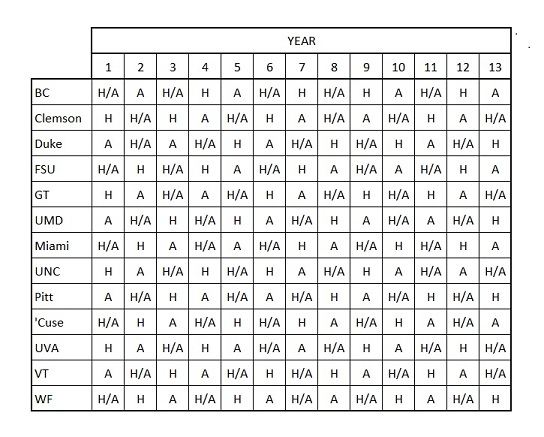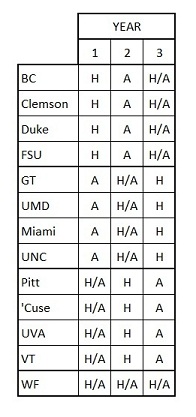How often do you get a chance to roll TV trivia into a title of a blog entry? For full credit, list the show, character’s name, and actor’s name that inspired this title. (no search engines allowed). Extra credit to those under 30 that know the answers without cheating.
As promised, we are going to take a look at some options for how an 18-game conference schedule will play out in a 14 team conference. Let’s set the ground rules with a big-picture view of what an 18-game schedule will look like:
– 5 opponents home/away
– 4 opponents at home
– 4 opponents away
.
.
EVEN ROTATION
If you accept the inevitable, you will acknowledge that the days of small conferences with round-robin conference schedules are gone forever. The next best thing would be a conference schedule designed such that over a given period of time, each team would play each opponent the same number of times. For 18 games with 14 teams, State’s rotation would look something like this:
Observations:
– When compared to a round-robin, you lose 8 games against each opponent over the 13 year rotation.
– While there are many ways to design the rotation, this one was designed such that no opponent was played H/A in consecutive years.
– If you want to see if this rotation is legitimate, you can check to see if each row and each column has five “H/A”, four “H”, and four “A”.
– Based on recent history, the conference makeup will change before we get through one complete rotation.
There is some chance (probably low) that this type of rotation will be put into place. However, this table was still worth putting together so that we can make comparisons to whatever rotation is actually put into place.
.
.
PRIMARY PARTNERS
Let’s look at the current ACC rotation to establish a baseline for what we are talking about:
– Two primary partners are played home/away every year (UNC and WF for State)
– The remaining nine opponents are divided into three rotating groups. One group is played H/A; one group is played at home; and the last group is played on the road. So after a three-year rotation, each team would have played each rotating opponent four times (twice at home and twice on the road).
– You can love this rotation or not, but you have to admit that it is a pretty simple system…at least it is simple AFTER you get through the process of assigning primary partners. (Though I have always thought that the ACC did a good job setting up the two primary partners in the 12-team conference.) Since the ACC is only adding two more teams (for now), it is impossible to assign Pitt and ‘Cuse two primary partners without disrupting at least some of the current partnerships.
I don’t know why the number of partners was set at “two” for the 12-team conference, but you have to admit that they certainly made the rotation for the remaining teams easy to figure out. I’m not saying that a simple rotation is a high priority, but if each of the 14 teams was assigned a single, primary partner, you could divide the remaining 12 opponents into three rotating groups like this:
Observations:
– The point of the table is to generically illustrate how the rotation could be put together. The opponents are just listed in semi-alphabetical order to make sure that I got everyone in the schedule somewhere.
– When compared to a round-robin schedule, each team would lose 8 games against each rotating opponent over a 12 year period. (Note that this is not substantially different than what would happen in the 13-year rotation schedule.
You probably caught that I listed WF as State’s primary partner. It’s not that difficult to imagine a primary partner setup like this:
FSU – Miami
GT – Clemson
UNC- Duke
State- WF
UVA – VT
Pitt, Syracuse, UMD, and BC in whatever combination that you would like.
In the forum thread on the 18 game schedule, someone quickly commented that Swofford would never risk losing a UNC/Duke game. I’m not really sure that Swofford really cares that much as long as the TV money stays the same. Put another way, you can be sure that Swofford will do whatever he can to appease ESPN if they call and express an opinion or concern. But in the end, whatever is done has to be approved by the ADs and coaches in the new ACC.
I really have no idea what or how many alliances/enemies we have among the 14 sets of coaches and ADs. But I’m sure that there will be some interesting conversations that we will never know about if the ACC elects to assign primary partners. Since the rotation wasn’t included in the ACC press release, I’m assuming that these types of discussions are currently being held.
.
.
EQUITABLE SCHEDULES
From Swofford’s press release:
The additional conference games create a more equitable schedule and we’ve received significant feedback from our fans for more conference games
We’ve looked at conference strength-of-schedule variations within the ACC several different times since the last expansion. The SOS variability comes from which teams you play once and which ones you play twice. One of the subtle implications of primary partners, is that those teamed with a consistently strong team will have a greater chance of playing one of the tougher conference schedules (and the converse is obviously true as well). So if we assume that Swofford really has any desire to achieve equitable schedules, then the new rotation won’t include more than one primary partner.
Let’s take a quick look at 16 games and 12 teams versus 18 games and 14 teams to see if both changes really produce a more equitable (less variable) schedule:
So the total number of opponents played only once increases as a gross number and as a percentage with the new changes. I’m not a whiz at calculating probablities….but you don’t need much of a calculation to see that this new schedule isn’t going to produce a “more equitble schedule”. In my estimation, you would need a 20 game conference schedule for 14 teams to actually accomplish Swofford’s stated goal. (But don’t hold your breath waiting for another increase in the conference schedule.)
.
.
PARTING THOUGHTS
If something substantially different is selected for the new rotation, then we can always come back to these and look for advantages/disadvantages. So for now, let the whining and wild alternatives begin….
.
.
.






You must be logged in to post a comment.